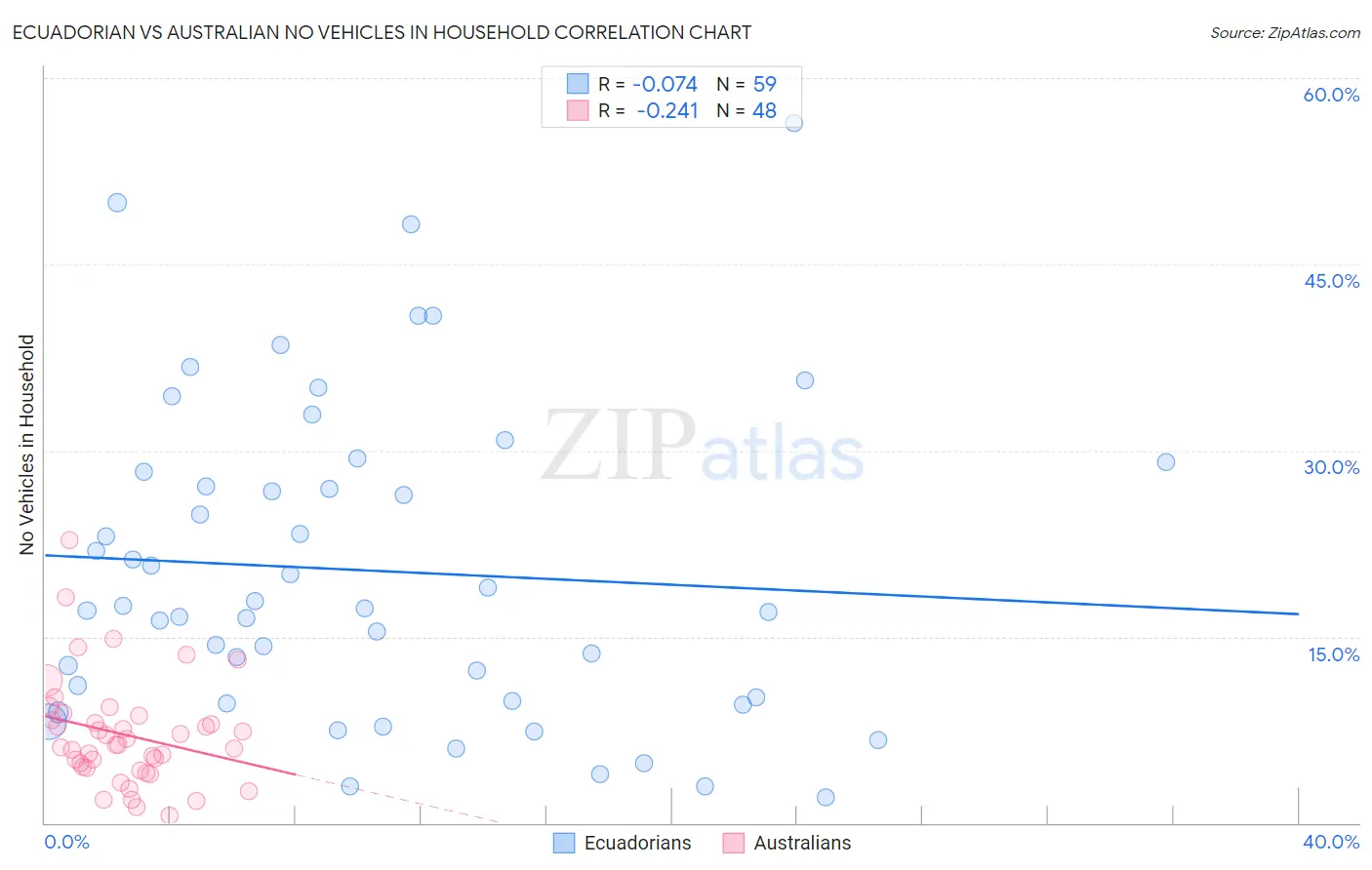Ecuadorian vs Australian No Vehicles in Household
COMPARE
Ecuadorian
Australian
No Vehicles in Household
No Vehicles in Household Comparison
Ecuadorians
Australians
22.8%
NO VEHICLES IN HOUSEHOLD
0.0/ 100
METRIC RATING
329th/ 347
METRIC RANK
10.1%
NO VEHICLES IN HOUSEHOLD
70.6/ 100
METRIC RATING
157th/ 347
METRIC RANK
Ecuadorian vs Australian No Vehicles in Household Correlation Chart
The statistical analysis conducted on geographies consisting of 317,233,310 people shows a slight negative correlation between the proportion of Ecuadorians and percentage of households with no vehicle available in the United States with a correlation coefficient (R) of -0.074 and weighted average of 22.8%. Similarly, the statistical analysis conducted on geographies consisting of 223,715,583 people shows a weak negative correlation between the proportion of Australians and percentage of households with no vehicle available in the United States with a correlation coefficient (R) of -0.241 and weighted average of 10.1%, a difference of 125.3%.

No Vehicles in Household Correlation Summary
| Measurement | Ecuadorian | Australian |
| Minimum | 2.1% | 0.57% |
| Maximum | 56.4% | 22.8% |
| Range | 54.3% | 22.2% |
| Mean | 20.3% | 7.1% |
| Median | 17.3% | 6.3% |
| Interquartile 25% (IQ1) | 9.8% | 4.5% |
| Interquartile 75% (IQ3) | 28.3% | 8.5% |
| Interquartile Range (IQR) | 18.5% | 4.0% |
| Standard Deviation (Sample) | 12.7% | 4.4% |
| Standard Deviation (Population) | 12.5% | 4.3% |
Similar Demographics by No Vehicles in Household
Demographics Similar to Ecuadorians by No Vehicles in Household
In terms of no vehicles in household, the demographic groups most similar to Ecuadorians are Immigrants from Dominica (22.2%, a difference of 2.3%), West Indian (23.7%, a difference of 4.2%), Trinidadian and Tobagonian (23.7%, a difference of 4.4%), Immigrants from Ecuador (23.8%, a difference of 4.7%), and Immigrants from Senegal (21.1%, a difference of 7.6%).
| Demographics | Rating | Rank | No Vehicles in Household |
| Immigrants | Cabo Verde | 0.0 /100 | #322 | Tragic 18.4% |
| Immigrants | Yemen | 0.0 /100 | #323 | Tragic 19.5% |
| Immigrants | Caribbean | 0.0 /100 | #324 | Tragic 19.6% |
| Senegalese | 0.0 /100 | #325 | Tragic 19.8% |
| Immigrants | West Indies | 0.0 /100 | #326 | Tragic 20.5% |
| Immigrants | Senegal | 0.0 /100 | #327 | Tragic 21.1% |
| Immigrants | Dominica | 0.0 /100 | #328 | Tragic 22.2% |
| Ecuadorians | 0.0 /100 | #329 | Tragic 22.8% |
| West Indians | 0.0 /100 | #330 | Tragic 23.7% |
| Trinidadians and Tobagonians | 0.0 /100 | #331 | Tragic 23.7% |
| Immigrants | Ecuador | 0.0 /100 | #332 | Tragic 23.8% |
| Immigrants | Trinidad and Tobago | 0.0 /100 | #333 | Tragic 24.6% |
| Immigrants | Bangladesh | 0.0 /100 | #334 | Tragic 25.8% |
| Barbadians | 0.0 /100 | #335 | Tragic 26.1% |
| Vietnamese | 0.0 /100 | #336 | Tragic 26.2% |
Demographics Similar to Australians by No Vehicles in Household
In terms of no vehicles in household, the demographic groups most similar to Australians are Immigrants from Micronesia (10.1%, a difference of 0.050%), Spanish American Indian (10.1%, a difference of 0.060%), Immigrants from Indonesia (10.1%, a difference of 0.21%), Salvadoran (10.1%, a difference of 0.30%), and Sioux (10.1%, a difference of 0.31%).
| Demographics | Rating | Rank | No Vehicles in Household |
| Colombians | 73.9 /100 | #150 | Good 10.0% |
| Immigrants | Eastern Africa | 73.8 /100 | #151 | Good 10.0% |
| Immigrants | Congo | 73.0 /100 | #152 | Good 10.1% |
| Tlingit-Haida | 72.5 /100 | #153 | Good 10.1% |
| Sioux | 72.4 /100 | #154 | Good 10.1% |
| Salvadorans | 72.4 /100 | #155 | Good 10.1% |
| Immigrants | Micronesia | 70.9 /100 | #156 | Good 10.1% |
| Australians | 70.6 /100 | #157 | Good 10.1% |
| Spanish American Indians | 70.2 /100 | #158 | Good 10.1% |
| Immigrants | Indonesia | 69.3 /100 | #159 | Good 10.1% |
| Immigrants | Middle Africa | 65.7 /100 | #160 | Good 10.2% |
| New Zealanders | 65.1 /100 | #161 | Good 10.2% |
| Immigrants | Austria | 64.4 /100 | #162 | Good 10.2% |
| Immigrants | Cambodia | 63.7 /100 | #163 | Good 10.2% |
| South Africans | 61.1 /100 | #164 | Good 10.2% |